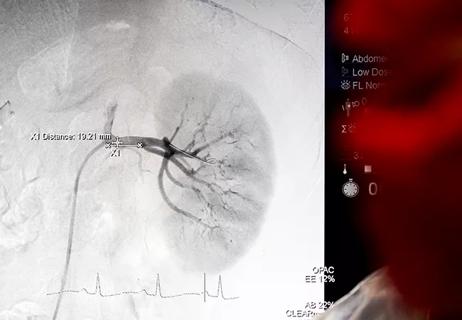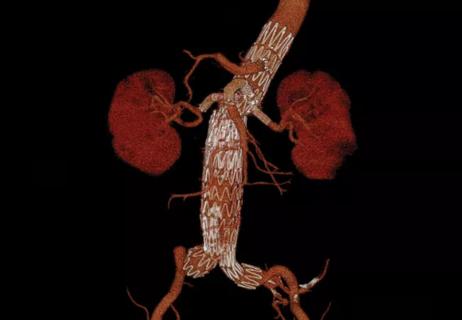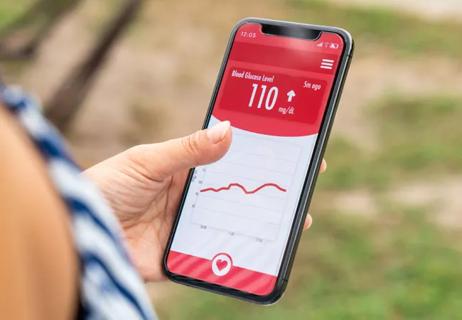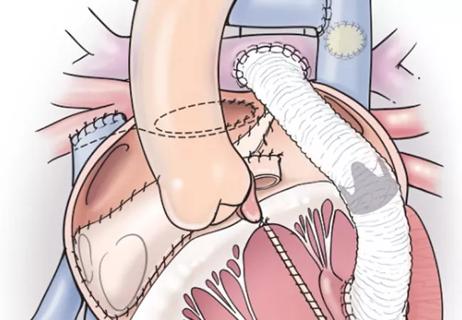Comprehensive advice for care before and after referral
By Oussama Wazni, MD; Ayman A. Hussein, MD; and Arun R. Mahankali Sridhar, MD, MPH
Cleveland Clinic is a non-profit academic medical center. Advertising on our site helps support our mission. We do not endorse non-Cleveland Clinic products or services. Policy
A 64-year-old man with hypertension but without known structural heart disease presents for a second opinion on management of his atrial fibrillation. The condition was first diagnosed at age 38, when he experienced palpitations and shortness of breath on exertion; at times he also experienced decreased endurance and fatigue without overt palpitations. At first, these episodes occurred about twice a year, and the patient was managed with a beta-blocker for rate control and an oral anticoagulant.
Over the past 10 years, the episodes have become more frequent and longer-lasting and have required frequent cardioversions. He was given flecainide for rhythm control but continued to have frequent episodes, so about one year ago he was switched to amiodarone, which controlled his rhythm better. However, after reading about side effects of amiodarone, he decided to seek a second opinion.
He was evaluated by our team and eventually underwent radiofrequency ablation. During the procedure, he was noted to have diffuse scarring and fibrosis of his left atrium, and afterward he continued to require antiarrhythmic drugs to maintain sinus rhythm.
Should he have been referred sooner? What factors should physicians consider when referring a patient with atrial fibrillation for ablation?
The goal of ablation is to prevent atrial fibrillation by eliminating the trigger that initiates it, altering the arrhythmogenic substrate, or both.
The most common ablation strategy is to electrically isolate the pulmonary veins by creating circumferential lesions around their antra. This creates a nonconducting rim of scar tissue, electrically disconnecting the pulmonary veins from the atrium.
Because recurrence rates are high in patients with persistent atrial fibrillation who undergo pulmonary vein ablation alone, the search continues for adjunctive strategies to improve outcomes. Although these strategies have a sound rationale based on experimental data and anecdotal evidence in humans, they have not yet been convincingly shown to be helpful in large clinical studies. Nonetheless, it is possible that more extensive substrate ablation — atrial “debulking” — could improve outcomes by reducing the amount of tissue that can fibrillate.
Linear ablation. Creating lines of ablation (as in the maze procedure) isolates different segments of the left atrium. Often, these lines are created along the roof of the left atrium between the right and left upper pulmonary veins and from the mitral valve to the left inferior pulmonary vein. The benefit of linear ablation has not been proven, and gaps in such lines may introduce atrial flutter.
Triggers not in the pulmonary veins. Common sites of nonpulmonary vein triggers include the posterior wall of the left atrium, the superior vena cava, the coronary sinus and along the ligament of Marshall. Provocative maneuvers such as isoproterenol infusion can help find those triggers, which can then be ablated. A limitation is that there is no protocol proven to reproducibly elicit triggers.
Complex fractionated atrial electrograms are areas in the atrium with highly fractionated, low voltage potentials. They may be critical sites of substrate for atrial fibrillation, and many electrophysiologists target them in patients with persistent atrial fibrillation. But despite initial enthusiasm, doing so has not resulted in better outcomes in persistent atrial fibrillation.
Rotors. Animal studies have shown that atrial fibrillation can be triggered or maintained by localized sources of organized reentrant circuits (rotors) or focal impulses. Recent studies have shown that these electrical rotors and focal sources could potentially be mapped and ablated in humans. But positive results in initial reports have not been reproduced, and this remains an area of controversy.
Our practice. We isolate the pulmonary veins with antral ablations, ablate the posterior wall, and extend the ablation toward the septum and inferior to the right pulmonary veins, with good long-term outcomes.1 The rationale behind ablating the posterior wall is that it shares embryologic origins with the pulmonary veins and may be a common source of triggers in atrial fibrillation.
We do not routinely create empiric ablation lines in the left or right atrium unless the patient has atrial flutter. Empiric ablation lines have not been convincingly shown to provide additional benefit compared with our extensive ablation approach, which involves the posterior wall. Empiric ablation of the appendage or coronary sinus is typically reserved for repeat ablation in patients with recurrent persistent atrial fibrillation.
To control symptoms. At this time, the primary aim of ablation is to reduce symptoms and improve quality of life. In theory, ablation could also decrease the risk of stroke, heart failure and death. However, these outcomes have not been systematically evaluated in any large randomized controlled trial.
To control rhythm and improve survival. Randomized controlled trials of rhythm versus rate control of atrial fibrillation2-4 have failed to demonstrate that restoring sinus rhythm is associated with better survival. All these trials used antiarrhythmic drugs for rhythm control. However, nonrandomized studies5,6 showed that maintaining sinus rhythm is associated with a significant reduction in mortality, whereas the use of antiarrhythmic drugs increased mortality risk.
This suggests that the beneficial effect of restoring sinus rhythm may be offset by adverse effects of antiarrhythmic drugs, and if rhythm control could be achieved by a method other than antiarrhythmic drug therapy, it may be superior to rate control. On the other hand, these data may be affected by residual confounding. This topic deserves further research, but maintaining sinus rhythm is typically preferred whenever possible.
Discontinuing anticoagulation is not a goal at this time. Retrospective studies have reported a low risk of stroke in patients who discontinue anticoagulation several months after undergoing ablation.7-9 However, atrial fibrillation can recur, and risk of stroke increases with age.
Therefore, guidelines10 still recommend continuing anticoagulation after ablation. Generally, we do not offer ablation with a goal of discontinuing anticoagulation. That said, stopping anticoagulation may be considered after long-term suppression of paroxysmal atrial fibrillation on a case-by-case basis in patients deemed to be at low risk. Left atrial appendage closure devices may eventually allow concomitant ablation and closure of the appendage, so that anticoagulation could then be stopped. This remains a topic of investigation.
Who should be considered for ablation? There are no absolute age or comorbidity contraindications to ablation. Everyone who has atrial fibrillation deserves, in our opinion, a referral to the electrophysiology clinic.
The decision to pursue ablation as opposed to trying drugs is nuanced, requiring a proper discussion with an electrophysiologist. The discussion of risks, benefits and alternatives, together with the shared decision-making process before a patient undergoes ablation, is the most time-consuming process in our clinic. Figure 1 shows our approach to deciding between ablation and medical management of atrial fibrillation.

Figure 1. Ablation versus medical management of atrial fibrillation. Most electrophysiologists in our institution use this general approach to decision-making.
Atrial fibrillation ablation is most often performed by electrophysiologists using a minimally invasive endovascular approach. The patient can be under moderate or general anesthesia; we prefer general anesthesia for patient comfort, safety and efficacy.
The catheter is inserted into the femoral vein and advanced into the right atrium. The interatrial septum is punctured under fluoroscopic and intracardiac echocardiographic guidance. Once the catheter is inside the left atrium, the antra of the pulmonary veins are located, and antral ablation is performed to electrically isolate the pulmonary veins from the atrial myocardium (Figure 2).

Figure 2. Fluoroscopic view of radiofrequency ablation. The PentaRay catheter is used to acquire data for three-dimensional mapping (Figure 5).
We use an electrogram-based technique to target and eliminate electrical potentials and ensure continuity of ablation sets, with additional guidance by three-dimensional cardiac mapping systems and intracardiac echocardiography. We also use contact force-sensing catheters to ensure catheter-tissue contact during ablation and to avoid excessive contact, which may enhance procedural safety.
Energy: Hot or cold. Two types of energy can be used for ablation:
In a randomized trial,11 these ablation technologies were shown to be equivalent for preventing recurrences of atrial fibrillation. We use both in our practice. The choice depends primarily on the planned ablation set, given that balloon cryoablation can achieve antral isolation of the pulmonary veins but allows little or no substrate modification.

Figure 3. A balloon catheter lodged in the ostium of one of the pulmonary veins to create a circumferential cryothermal lesion, electrically isolating the pulmonary vein.
Intracardiac echocardiography, performed with an endovascular catheter in the right atrium, directly displays the interatrial septum, left atrium, pulmonary veins, ablation catheter and catheter-tissue interface during ablation (Figure 4). It is used to guide transseptal puncture, assess tissue-catheter contact during ablation and monitor for complications. We also use it in balloon cryothermal ablation to ensure proper occlusion of the targeted pulmonary vein by Doppler assessment.

Figure 4. Intracardiac echocardiographic images. A, view with the probe located in the right atrium. B, view during transseptal puncture, routinely performed under intracardiac echocardiographic guidance. AV = aortic valve; LA = left atrium; RA = right atrium; RV = right ventricle; RVOT = right ventricular outflow tract.
Contact force-sensing catheters. Radiofrequency ablation catheters are now equipped with a pressure sensor at the tip that measures how hard the catheter is pressing on the heart wall.12,13 In our experience, this has improved the outcomes of ablation procedures, primarily in persistent atrial fibrillation.14
Three-dimensional cardiac mapping is now universally used for ablation. It uses either electromagnetic data or impedance data to create a real-time three-dimensional map of the heart (Figure 5) and to indicate the position of the ablation catheter. This technology significantly reduces the radiation dose to the patient and the operator.

Figure 5. Three-dimensional voltage mapping of the left atrium. Top row, before ablation. Bottom row, after ablation. Voltage is color-coded: pink represents good voltage, red represents very low voltage, and other colors represent other points in the spectrum. LIPV = left inferior pulmonary vein; LSPV = left superior pulmonary vein; RIPV = right inferior pulmonary vein; RSPV = right superior pulmonary vein.
Although catheter ablation for atrial fibrillation is safe, it is still one of the most complex electrophysiologic procedures. Improvements in technology and techniques and accumulated experience over the past 15 years have made ablation safer, especially in tertiary care centers. But adverse outcomes are more frequent in low-volume centers.15
Minor procedural complications include pericarditis, complications at the vascular access site and anesthesia-related complications. While they do not affect the patient’s long-term outcome, they may increase hospital length of stay and cause temporary inconvenience.
Major complications include cardiac perforation and tamponade, periprocedural stroke, pulmonary vein stenosis, atrioesophageal fistula, phrenic nerve paralysis, major bleeding, myocardial infarction and death. In a worldwide survey published in 2005, when atrial fibrillation ablation was still novel, the rate of major complications was 6 percent.16 By 2010, this had declined to 4.5 percent,17 and rates of major complications may be significantly lower in more experienced centers.15 In our practice, in 2015, the rate of major complications was 1.3 percent (unpublished data).
Clinical outcomes depend on many factors, including type of atrial fibrillation (paroxysmal vs. nonparoxysmal), overall health of the atria (atrial size and scarring), patient age and comorbidities and, most importantly, the center’s and operator’s experience.
In randomized controlled trials comparing ablation and antiarrhythmic drug therapy, the efficacy of ablation in maintaining sinus rhythm has been in the range of 66 to 86 percent versus 16 to 22 percent for drug therapy,18,19 but these trials have been predominantly in middle-aged white men with paroxysmal atrial fibrillation. These trials also showed that catheter ablation reduced symptoms and improved quality of life. Ablation is less effective in persistent than in paroxysmal atrial fibrillation.20
In a long-term study from our group,1 660 (79.4 percent) of 831 patients who underwent ablation in 2005 were arrhythmia-free and not on antiarrhythmic drug therapy after a total of 1,019 ablations (an average of 1.2 ablations per patient) at a median of 55 months; 125 patients (15 percent, 41 with > 1 ablation) continued to have atrial arrhythmia, which was controlled with drugs in 87 patients (69.6 percent). Only 38 patients (4.6 percent) continued to have drug-resistant atrial fibrillation and were treated with rate control with negative dromotropic agents.
The largest randomized controlled trial of catheter ablation versus drug therapy for atrial fibrillation (Catheter Ablation Versus Antiarrhythmic Drug Therapy for Atrial Fibrillation [CABANA]) was completed recently.21 A total of 2,204 patients with atrial fibrillation (42.4 percent paroxysmal, 47.3 percent persistent and 10.3 percent long-standing persistent) were randomized to either ablation or drug therapy. Median follow-up was four years. The crossover rate was high — 9.2 percent of those randomized to ablation did not undergo it, and 27.5 percent of those randomized to drug therapy underwent ablation.
The incidence of the primary end point (a composite of death, disabling stroke, serious bleeding and cardiac arrest) was not significantly different between the two groups in the intention-to-treat analysis; however, given the high crossover rates, the as-treated and per-protocol analyses become important, and as-treated and per-protocol analyses revealed a significant benefit of ablation compared with drug therapy. The hazard ratio (HR) for the primary composite outcome was 0.67 (P = .006) on as-treated analysis and 0.73 (P = .05) on per-protocol analysis. The HR for all-cause mortality was 0.60 (P = .005) on as-treated analysis.
Periprocedural anticoagulation. The risk of thromboembolism is increased during, immediately following, and for several weeks to months after ablation.22,23
During the procedure, the risk is related to transseptal sheath placement, electrode catheters in the left atrium and char formation on ablation catheters. These risks are mitigated with proper and careful sheath and catheter manipulation, maintenance of bubble-free irrigation through lines and sheaths, use of irrigated catheters, and initiation of heparin before transseptal access. Heparin is also infused during the procedure, with close monitoring of activated clotting time.
Postprocedurally, the transiently increased clotting risk could be due to damaged endothelium from the ablation itself and stunning of atrial tissue, which results in impaired contraction. Damaged endothelium improves as the tissue heals, and the stunning resolves by electrical reverse remodeling with sinus rhythm maintenance.
In view of these risks, the referring physician and electrophysiologist must pay careful attention to anticoagulation before and after ablation:
Some patients actually experience more atrial fibrillation in the first weeks to months after the procedure. The mechanism in this setting may be different from that causing the arrhythmia in the first place. Causes of early recurrence of atrial arrhythmias include postablation inflammation, temporary autonomic imbalance and delay of atrial radiofrequency lesion formation.26,27 These arrhythmias may completely resolve as the ablation lesions heal and scars mature.
It has been hypothesized that short-term use of antiarrhythmic drugs after ablation is effective in preventing arrhythmias because it alters atrial electrophysiologic characteristics induced by the above transient factors. A recent systematic review of six clinical trials showed that short-term use of antiarrhythmic drugs reduces the risk of early arrhythmia recurrence but does not reduce recurrence in the long term.28
In terms of outcomes, any arrhythmias that occur in the first three months do not necessarily affect long-term success. This is referred to as the “blanking period.” However, generally speaking, it is preferable to maintain sinus rhythm during that time to avoid further anatomic or electrical left atrial adverse remodeling. In many situations, patients continue taking the same antiarrhythmic agent or start on antiarrhythmic therapy in the first few months after ablation.29,30
The mechanisms of late recurrence of atrial arrhythmias after ablation are thought to be different from those in early recurrence. Late recurrence has been ascribed to incomplete pulmonary vein isolation, recovery of pulmonary vein-left atrium connections or recovery of any other lines of ablation created in the procedure.31,32 For late recurrence of atrial arrhythmia, studies and guidelines suggest that repeat ablation may be an option.10,33
Before the procedure, some electrophysiologists use cardiac CT or MRI to evaluate the pulmonary vein anatomy. This helps in planning and in selecting the appropriate tools for the procedure.
The patient is asked to fast on the day of the procedure. The procedure can take three to six hours, depending on the patient’s anatomy and the operator’s technique and experience. It can be performed with the patient under general anesthesia or conscious sedation. Currently, we use general anesthesia most of the time to maximize patient comfort.
After the procedure, our patients must remain in bed for four hours and stay overnight for observation. If no complications arise, they are discharged the next day.
This post is a shortened adaptation of a review article published in the October 2018 issue of Cleveland Clinic Journal of Medicine(2018;85:789-799).
Dr. Wazni is Section Head of Electrophysiology and Cardiac Pacing at Cleveland Clinic, and Dr. Hussein is a staff electrophysiologist in the section. Dr. Sridhar, currently an electrophysiologist at the University of Washington in Seattle, recently completed an electrophysiology fellowship at Cleveland Clinic.

General principles for use of the long-awaited new therapy approach

ACC panel issues call to action to achieve CV health equity in an underserved population

Get a glimpse of the facilities and technologies used by the nation’s top-ranked heart program

EVAR pioneer Dr. Juan Parodi surveys the past and future of a revolutionary procedure

Latest systems combine continuous glucose monitoring with automatic basal insulin delivery

Common congenital lesion is not always benign

New study yields pre-pandemic insights for the post-pandemic landscape

Series of five patients successfully treated with ‘ventricular switch’